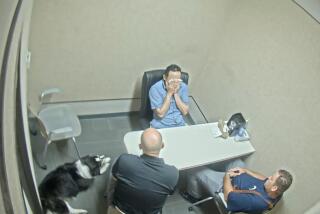Tire Marks at Murder Scene Matched Size of Peyerâs Car
A San Diego police detective testified Wednesday that skid marks found at the scene where Cara Knott was killed matched the wheelbase of the California Highway Patrol car driven by Officer Craig Peyer.
Homicide Detective Gene Back said the marks found Dec. 28 were too faint to obtain a tread design, but he said the distance between the tire tracks was 53 inches, equal to the the wheelbase of Peyerâs CHP cruiser.
Back said the marks were fresh and that, when he rubbed his fingers over the tracks, he picked up a black, rubbery residue. However, Back did not offer an opinion as to when the skid marks were made.
Tracks on Bridge
Homicide investigators discovered the tire tracks on the old U.S. 395 bridge near the Mercy Road off-ramp and Interstate 15, where police say that Knott, 20, was strangled on Dec. 27 and her body thrown from the bridge, 75 feet down into a dry creek bed.
Nineteen young women testified Tuesday and Wednesday that Peyer, 37, stopped them at night on Interstate 15 during 1986 and ordered them to drive down the isolated and darkened Mercy Road off-ramp. Some women testified that the stops lasted more than 45 minutes, and one woman said that Peyer detained her for one hour and 40 minutes while he questioned her about her job and talked about his personal life.
However, none of the women has said that she complained to CHP officials about being stopped, and all said that Peyer never touched them or asked them for a date. Several said that Peyer impressed them because of his concern for their safety.
But on Wednesday, Peyerâs superior criticized the nighttime traffic stops and called them âunusual.â Capt. Lee Denno, commander of the CHPâs San Diego office, also said that Peyer violated department regulations when he stopped a woman and later drove her in his cruiser to pick up her infant daughter at the baby sitter before driving them to their Poway home.
Area Poorly Lighted
âThe (Mercy Road off-ramp) location is out of the ordinary. Most of these stops occurred during darkness. The area is not well-lit and (is) isolated,â Denno said when asked by Deputy Dist. Atty. Joseph van Orshoven to comment about the stops.
Denno had previously characterized the stops as unusual because of the site where they were made, the length of time that Peyer spent talking to the women, the personal conversations that he had with them and because Peyer made some women back up on the freeway shoulder so they could drive down the off-ramp. He said that most âtraffic stops would take between 10 and 15 minutes.â
Under questioning by Robert Grimes, who is Peyerâs attorney, Denno said that CHP officials allow an officer to use his discretion to order drivers to pull off the freeway if the officer fears for his or the driverâs safety. Denno also acknowledged that one young woman had called his office to complain about a CHP officer who had ordered her to stop at the off-ramp.
The CHP sergeant who took the complaint told the woman that the unidentified officer had the discretion to order her down the off-ramp if he thought it was a safer place to park, Denno said. He did not say when the incident happened.
Rope Found in Car
Denno also testified that a piece of rope about half an inch thick and 2 feet long that was found by San Diego police homicide investigators in the trunk of Peyerâs cruiser was not standard CHP equipment. The rope had a loop at one end and tape at both ends. Police have not recovered the murder weapon but believe that Knott may have been strangled with a rope.
Police recovered two other ropes from Peyerâs patrol car that Denno said were standard CHP equipment. One is used as a leg restraint and kept in the carâs glove compartment. The other is a rope running through a piece of plastic pipe about four feet long with a loop at one end that is used as an animal snare.
Homicide Detective Grant Raybould testified that Peyer denied all knowledge of the non-departmental rope recovered from the trunk during a three-hour interview that he had with Peyer on Jan. 9, six days before his arrest.
âHe described the two ropes that were standard equipment. . . . He made the statement that there were no other ropes in the car,â Raybould said. â . . . Craig described a lot of items that were standard equipment. He said that he was a very meticulous individual and checked his trunk every night.â
Peyer told homicide investigators that he had never seen the rope in question and said that there was no reason for the extra rope to be in the trunk, Raybould said.
The parade of young women who testified about Peyerâs unusual stops continued Wednesday. Kathleen Deir, 29, of San Diego, testified that Peyer gave her a nighttime tour of the area where Knott was murdered on Dec. 11, 16 days before Knottâs death.
Ordered to Bridge
Deir said that she was southbound on Interstate 15 when Peyer stopped her at 8:15 p.m. near the Mercy Road off-ramp and ordered her to drive down it. She said that Peyer told her that one of her headlights was âtoo low.â The stop took more than an hour, Deir said, and Peyer talked to her about her hometown of Tucson, San Diego and the area freeways.
At one point, Deir testified, Peyer told her to lock her car door, asked her to get inside his CHP cruiser and took her to the U.S. 395 bridge where Knott was strangled.
Amy Hoeppner, 21, currently a security guard at May Co. in El Cajon, testified that Peyer stopped her twice within a period of 11 days on Interstate 15 and both times ordered her to drive down the Mercy Road off-ramp. Peyer stopped her on Nov. 26 and Dec. 7, Hoeppner said, when she was working at the May Co. store in Escondido.
On Nov. 26, Peyer stopped her at 9:45 p.m. because one of her headlights was supposedly dim, she said. Hoeppner said that the light did not appear dim to her and Peyer did not give her a ticket. Instead, he talked to her for about 45 minutes about âretail security,â she said.
On Dec. 7, Peyer stopped her again between 9:15 and 9:30 p.m. and used the CHP carâs public address system to direct her car down the Mercy Road off-ramp.
âI recognized him and said, âItâs you again,â â Hoeppner said. âHe appeared startled, stuttered and said, âYour headlight still appears dim.â At that point he said, âWeâve got to stop meeting like this.â â
Dana Breslow, 26, of San Diego said that Peyer stopped her one December night at 10 p.m. Breslow said that she initially resisted his order to drive down the Mercy Road off-ramp but got âscaredâ and drove down the off-ramp when he repeated the order âwith more force.â
Unlike most of the other women who testified, Breslow said that she refused to get out of her car when Peyer walked up to her, and that she became âvery leeryâ when Peyer began talking to her.
âSeemed Lonelyâ
âHe seemed lonely and wanted to talk. . . . I didnât feel that anything he asked me was any of his business,â Breslow said. Although the stop took only 20 minutes, Breslow said that âit just seemed to me an awful long time to be talking to me late at night.â
Cheryl Ann Johnson, 26, said that Peyer stopped her for an hour and 40 minutes on June 25. The stop occurred at 8:30 p.m., Johnson said, but it was not until an hour later that Peyer told her that he stopped her for speeding. But after learning that she was a pediatric nurse, Peyer ticketed her instead for having a bald right rear tire, even though her tires were new, Johnson said.
âHe said âI need something to write up once I start a ticket,â â Johnson said.
Adele Tollgaard said that Peyer stopped her Oct. 3 between 8:30 and 9:30 p.m., and followed her for quite a while on Interstate 15 before stopping her at the Mercy Road off-ramp. After he stopped her, Peyer checked her car and told her that she had a bad oil leak that could be a fire hazard, Tollgaard said.
After giving her some safety tips, Tollgaard said, Peyer told her to leave her car at the off-ramp, drove her to pick up her daughter at a baby sitterâs house and then drove the two of them to their Poway home.
âHe was so considerate in checking everything (on her car) . . . I asked him if he wanted to do my windows too,â Tollgaard said.
Tollgaard and several of the women who testified were driving Volkswagen cars when they were stopped. Knott, a San Diego State University honor student, was driving a white Volkswagen on the night she was killed. The car was recovered at the bottom of the Mercy Road off-ramp, near the bridge where she was strangled.
Some women said that Peyer stopped them because the lights above their rear license plates were not working. On Wednesday, Detective Back said that the bulb above the license plate on Knottâs Volkswagen was inoperative when he checked the car on Jan. 12, three days before Peyerâs arrest.
More to Read
Sign up for Essential California
The most important California stories and recommendations in your inbox every morning.
You may occasionally receive promotional content from the Los Angeles Times.










